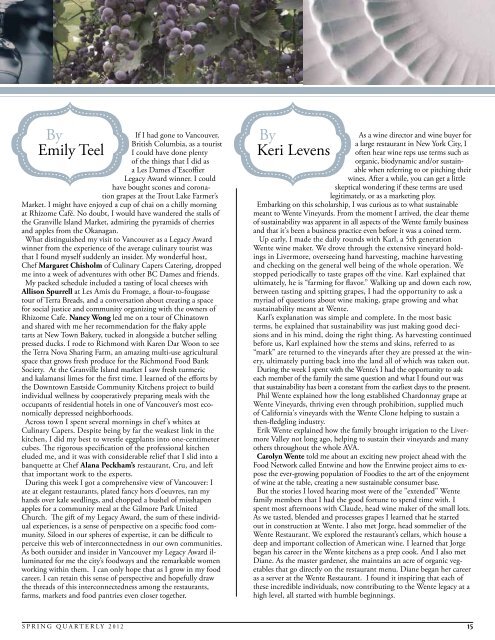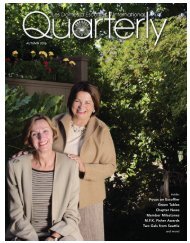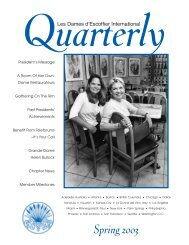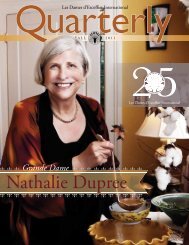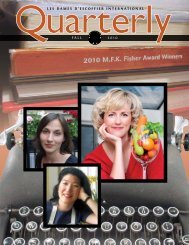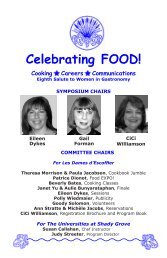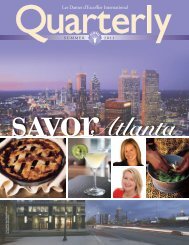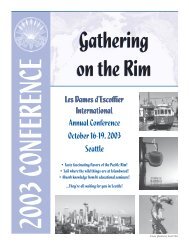cuisine, culture and community - Les Dames d'Escoffier International
cuisine, culture and community - Les Dames d'Escoffier International
cuisine, culture and community - Les Dames d'Escoffier International
You also want an ePaper? Increase the reach of your titles
YUMPU automatically turns print PDFs into web optimized ePapers that Google loves.
By<br />
Emily Teel<br />
If I had gone to Vancouver,<br />
British Columbia, as a tourist<br />
I could have done plenty<br />
of the things that I did as<br />
a <strong>Les</strong> <strong>Dames</strong> d’Escoffier<br />
Legacy Award winner. I could<br />
have bought scones <strong>and</strong> coronation<br />
grapes at the Trout Lake Farmer’s<br />
Market. I might have enjoyed a cup of chai on a chilly morning<br />
at Rhizome Café. No doubt, I would have w<strong>and</strong>ered the stalls of<br />
the Granville Isl<strong>and</strong> Market, admiring the pyramids of cherries<br />
<strong>and</strong> apples from the Okanagan.<br />
What distinguished my visit to Vancouver as a Legacy Award<br />
winner from the experience of the average culinary tourist was<br />
that I found myself suddenly an insider. My wonderful host,<br />
Chef Margaret Chisholm of Culinary Capers Catering, dropped<br />
me into a week of adventures with other BC <strong>Dames</strong> <strong>and</strong> friends.<br />
My packed schedule included a tasting of local cheeses with<br />
Allison Spurrell at <strong>Les</strong> Amis du Fromage, a flour-to-fougasse<br />
tour of Terra Breads, <strong>and</strong> a conversation about creating a space<br />
for social justice <strong>and</strong> <strong>community</strong> organizing with the owners of<br />
Rhizome Cafe. Nancy Wong led me on a tour of Chinatown<br />
<strong>and</strong> shared with me her recommendation for the flaky apple<br />
tarts at New Town Bakery, tucked in alongside a butcher selling<br />
pressed ducks. I rode to Richmond with Karen Dar Woon to see<br />
the Terra Nova Sharing Farm, an amazing multi-use agricultural<br />
space that grows fresh produce for the Richmond Food Bank<br />
Society. At the Granville Isl<strong>and</strong> market I saw fresh turmeric<br />
<strong>and</strong> kalamansi limes for the first time. I learned of the efforts by<br />
the Downtown Eastside Community Kitchens project to build<br />
individual wellness by cooperatively preparing meals with the<br />
occupants of residential hotels in one of Vancouver’s most economically<br />
depressed neighborhoods.<br />
Across town I spent several mornings in chef’s whites at<br />
Culinary Capers. Despite being by far the weakest link in the<br />
kitchen, I did my best to wrestle eggplants into one-centimeter<br />
cubes. The rigorous specification of the professional kitchen<br />
eluded me, <strong>and</strong> it was with considerable relief that I slid into a<br />
banquette at Chef Alana Peckham’s restaurant, Cru, <strong>and</strong> left<br />
that important work to the experts.<br />
During this week I got a comprehensive view of Vancouver: I<br />
ate at elegant restaurants, plated fancy hors d’oeuvres, ran my<br />
h<strong>and</strong>s over kale seedlings, <strong>and</strong> chopped a bushel of misshapen<br />
apples for a <strong>community</strong> meal at the Gilmore Park United<br />
Church. The gift of my Legacy Award, the sum of these individual<br />
experiences, is a sense of perspective on a specific food <strong>community</strong>.<br />
Siloed in our spheres of expertise, it can be difficult to<br />
perceive this web of interconnectedness in our own communities.<br />
As both outsider <strong>and</strong> insider in Vancouver my Legacy Award illuminated<br />
for me the city’s foodways <strong>and</strong> the remarkable women<br />
working within them. I can only hope that as I grow in my food<br />
career, I can retain this sense of perspective <strong>and</strong> hopefully draw<br />
the threads of this interconnectedness among the restaurants,<br />
farms, markets <strong>and</strong> food pantries even closer together.<br />
By<br />
Keri Levens<br />
As a wine director <strong>and</strong> wine buyer for<br />
a large restaurant in New York City, I<br />
often hear wine reps use terms such as<br />
organic, biodynamic <strong>and</strong>/or sustainable<br />
when referring to or pitching their<br />
wines. After a while, you can get a little<br />
skeptical wondering if these terms are used<br />
legitimately, or as a marketing ploy.<br />
Embarking on this scholarship, I was curious as to what sustainable<br />
meant to Wente Vineyards. From the moment I arrived, the clear theme<br />
of sustainability was apparent in all aspects of the Wente family business<br />
<strong>and</strong> that it's been a business practice even before it was a coined term.<br />
Up early, I made the daily rounds with Karl, a 5th generation<br />
Wente wine maker. We drove through the extensive vineyard holdings<br />
in Livermore, overseeing h<strong>and</strong> harvesting, machine harvesting<br />
<strong>and</strong> checking on the general well being of the whole operation. We<br />
stopped periodically to taste grapes off the vine. Karl explained that<br />
ultimately, he is “farming for flavor.” Walking up <strong>and</strong> down each row,<br />
between tasting <strong>and</strong> spitting grapes, I had the opportunity to ask a<br />
myriad of questions about wine making, grape growing <strong>and</strong> what<br />
sustainability meant at Wente.<br />
Karl’s explanation was simple <strong>and</strong> complete. In the most basic<br />
terms, he explained that sustainability was just making good decisions<br />
<strong>and</strong> in his mind, doing the right thing. As harvesting continued<br />
before us, Karl explained how the stems <strong>and</strong> skins, referred to as<br />
“mark” are returned to the vineyards after they are pressed at the winery,<br />
ultimately putting back into the l<strong>and</strong> all of which was taken out.<br />
During the week I spent with the Wente’s I had the opportunity to ask<br />
each member of the family the same question <strong>and</strong> what I found out was<br />
that sustainability has been a constant from the earliest days to the present.<br />
Phil Wente explained how the long established Chardonnay grape at<br />
Wente Vineyards, thriving even through prohibition, supplied much<br />
of California's vineyards with the Wente Clone helping to sustain a<br />
then-fledgling industry.<br />
Erik Wente explained how the family brought irrigation to the Livermore<br />
Valley not long ago, helping to sustain their vineyards <strong>and</strong> many<br />
others throughout the whole AVA.<br />
Carolyn Wente told me about an exciting new project ahead with the<br />
Food Network called Entwine <strong>and</strong> how the Entwine project aims to expose<br />
the ever-growing population of Foodies to the art of the enjoyment<br />
of wine at the table, creating a new sustainable consumer base.<br />
But the stories I loved hearing most were of the "extended" Wente<br />
family members that I had the good fortune to spend time with. I<br />
spent most afternoons with Claude, head wine maker of the small lots.<br />
As we tasted, blended <strong>and</strong> processes grapes I learned that he started<br />
out in construction at Wente. I also met Jorge, head sommelier of the<br />
Wente Restaurant. We explored the restaurant’s cellars, which house a<br />
deep <strong>and</strong> important collection of American wine. I learned that Jorge<br />
began his career in the Wente kitchens as a prep cook. And I also met<br />
Diane. As the master gardener, she maintains an acre of organic vegetables<br />
that go directly on the restaurant menu. Diane began her career<br />
as a server at the Wente Restaurant. I found it inspiring that each of<br />
these incredible individuals, now contributing to the Wente legacy at a<br />
high level, all started with humble beginnings.<br />
SPRING Quarterly 2012 15


